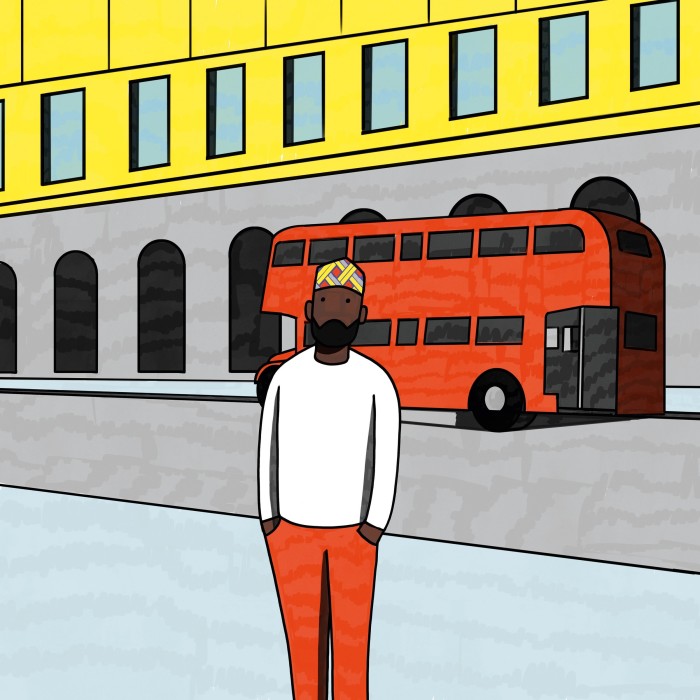How I spend it… Inua Ellams on Zanna Bukar hats

Simply sign up to the Fashion myFT Digest -- delivered directly to your inbox.
I was 12 when I left Nigeria. I returned in 2012, after 16 years, to perform at the Lagos International Theatre Festival. At Heathrow Airport, as the plane bunched for takeoff, I recall talking to myself. Calm down, Inua. This is nothing. It’s not like the country will embrace you, or anything that ridiculous. This ain’t no prodigal-son shit. It’s just work. Chill.
Yet, when I stepped off the plane, after years of being in a minority ethnic group in Europe, standing in the most populous country in Africa, slipping into its tide of black faces, actually being able to “blend in”, meant more than I could have ever imagined. Over the next few days, I slowly realised there was no chance of random racist abuse whatsoever. Those who asked me for any form of ID asked everybody else. I didn’t have to second-guess why taxis didn’t stop when I waved them down. The constant being-on-edgeness I was used to in England softened, then entirely dissipated. My spine relaxed into itself, my chest broadened and, as if recalling their kinship with wings, my shoulder blades straightened out, reaching upwards.
I returned to London and wanted to walk as tall as I had in Nigeria, with that sense of black privilege and belonging. I had started balding and wanted something other than the flat caps and beanies I’d been wearing. It was then I reached for my Zanna Bukar hat. My father had bought a pair for us to wear at my sister’s wedding and I hadn’t worn mine since. Zanna Bukars were popularised by the eponymous northern Nigerian Muslim politician who’d worn them in the early ’60s. They were adopted right across the north, and quite a few men had been wearing them in the south, in Lagos. I slipped it on and stepped out into the streets of Peckham where I lived.
Three things happened, the first almost immediately: a stranger greeted me with brotherly warmth. “As-salāmu ‘alaykum,” he said – the typical Muslim greeting – to which I instinctively replied, “Wa ‘alaykumu s-salām.” Secondly, I saw police officers harassing a group of young black men and whereas I’d be nervous of “fitting the description”, I realised that broad net of a reason – to stop and search us – could no longer apply to me. The police would have to do better; the hat stood out so much, the only description I could fit was mine. This was also the third thing. When I arrived at my destination, a performance poetry event, because it stood out so much, the largely non-black audience was able to pick me out of the largely black-male line up. Just like that, the hat solved three problems where I thought it would solve one. I started wearing my Zanna Bukar everywhere. It felt like an equivalent to Clark Kent’s cape.
The next time I visited Nigeria, I bought more Zanna Bukars. Whenever a friend was going, I’d request more. At the Ake Festival, Nigeria’s largest and best attended literature event, I heard of a tailor who designed bespoke Zanna Bukars. I found him, ordered five, and was so impressed I ordered another set, and another the following year. They cost between 10,000 and 25,000 Naira (£20 to £50), their styles and colours vast and varied. Some have gorgeous geometric patterns, of the kind you might find on prayer mats; others are bold, single-toned cloth sculptures; some are perforated; others tightly meshed – and I couldn’t keep from buying more.
A few years ago, I was invited to a reception at Buckingham Palace. They have a strict no-hat policy for men, but fearing cultural sensibilities (I imagine) I wasn’t relieved of mine. I like to think, as I shook the Queen’s hand, she was wearing her crown as I was wearing mine. I now call that hat The Queen Elizabeth. There’s one with a silver bird I sewed to the front called Jennifer Lawrence; another, Jon Daniel, after the artist who passed away in 2017. A brown one called The Regal, Black Beauty – a thin, slick silk number, and for the gold horse pendant I pinned to the front, Akhal-Teke, after the golden horses that came from Turkmenistan.
Shortly after the EU referendum, a man knocked me to the ground in Waterloo Station and spat, “Take that fucking hat off.” He didn’t stop me wearing them. I currently have 36 Zanna Bukars, traditional and bespoke, and I just want more!
I recently had a play touring, an adaptation of The Little Prince by Antoine de Saint-Exupéry. The Little Prince himself was played by a puppet the cast called Aliu, but who my producer affectionately named Little Inua. Set in a parallel Afrofuturist galaxy, he too wears a Zanna Bukar, which is a roundabout way of saying the sky isn’t the limit to my growing collection – perhaps outer space is.
Comments